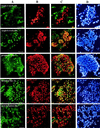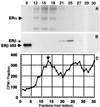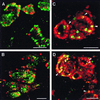Estrogen receptors alpha and beta in the rodent mammary gland
- PMID: 10618419
- PMCID: PMC26664
- DOI: 10.1073/pnas.97.1.337
Estrogen receptors alpha and beta in the rodent mammary gland
Abstract
An obligatory role for estrogen in growth, development, and functions of the mammary gland is well established, but the roles of the two estrogen receptors remain unclear. With the use of specific antibodies, it was found that both estrogen receptors, ERalpha and ERbeta, are expressed in the rat mammary gland but the presence and cellular distribution of the two receptors are distinct. In prepubertal rats, ERalpha was detected in 40% of the epithelial cell nuclei. This decreased to 30% at puberty and continued to decrease throughout pregnancy to a low of 5% at day 14. During lactation there was a large induction of ERalpha with up to 70% of the nuclei positive at day 21. Approximately 60-70% of epithelial cells expressed ERbeta at all stages of breast development. Cells coexpressing ERalpha and ERbeta were rare during pregnancy, a proliferative phase, but they represented up to 60% of the epithelial cells during lactation, a postproliferative phase. Western blot analysis and sucrose gradient centrifugation confirmed this pattern of expression. During pregnancy, the proliferating cell nuclear antigen was not expressed in ERalpha-positive cells but was observed in 3-7% of ERbeta-containing cells. Because more than 90% of ERbeta-bearing cells do not proliferate, and 55-70% of the dividing cells have neither ERalpha nor ERbeta, it is clear that the presence of these receptors in epithelial cells is not a prerequisite for estrogen-mediated proliferation.
Figures






References
-
- Russo J, Russo I H. Medicina. 1997;57, Suppl 2:81–91. - PubMed
-
- Prall O W, Rogan E M, Sutherland R L. J Steroid Biochem Mol Biol. 1998;65:169–174. - PubMed
-
- Zeps N, Bentel J M, Papadimitriou J M, D'Antuono M F, Dawkins H J. Differentiation. 1998;62:221–226. - PubMed
-
- Clarke R B, Howell A, Potten C S, Anderson E. Cancer Res. 1997;57:4987–4991. - PubMed
-
- Clarke R B, Howell A, Anderson E. Breast Cancer Res Treat. 1997;45:121–133. - PubMed
Publication types
MeSH terms
Substances
LinkOut - more resources
Full Text Sources

